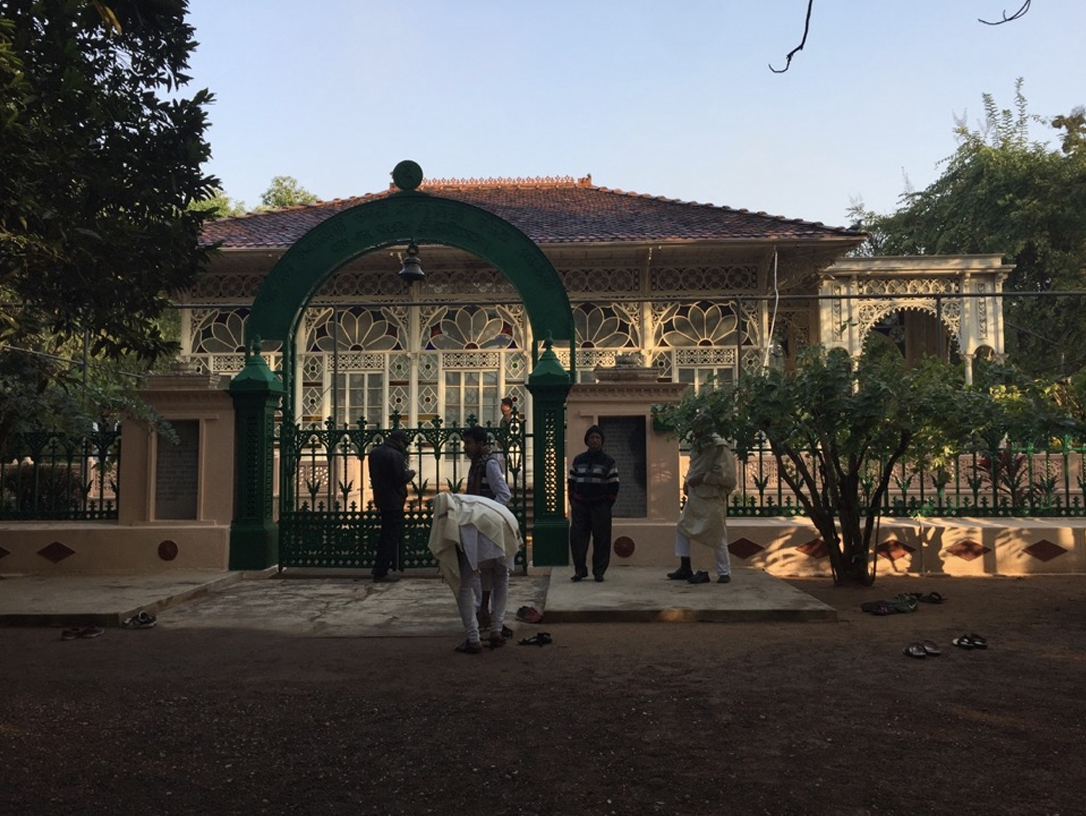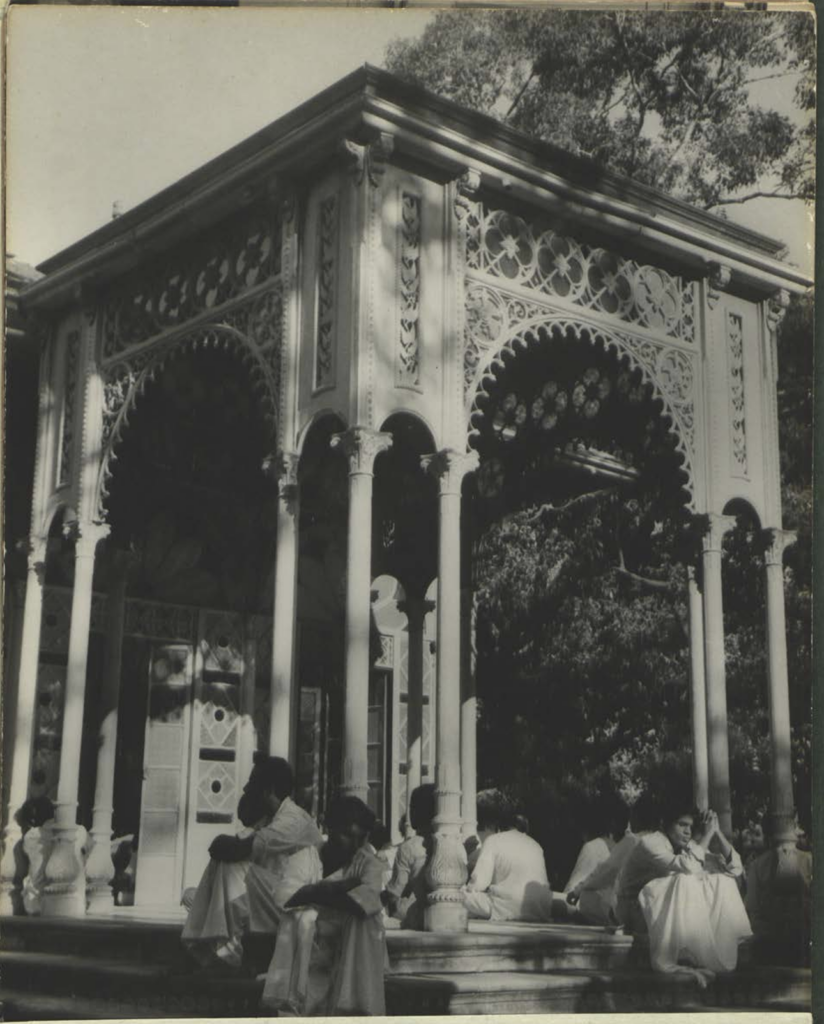Amita Sinha
Upasana Griha (prayer house) is a major landmark in Visva-bharati campus established as an ashram (hermitage) in Shantiniketan by the poet-laureate Rabindranath Tagore. It is one of the 41 built structures in the nomination dossier prepared by the Government of India for inscribing Shantiniketan on UNESCO World Heritage List and recently restored.1 While the history, design, and context of the glass temple are important in assessing its heritage value, the subjective experience of participating in prayer meetings held in it is essential to understanding its meaning as a spiritual sanctuary.
Upasana Griha was built directly in axis with Chattim Tala, the place where Debendranath Tagore, Rabindranath’s father, had a revelation when he was meditating in a glade of Chattim trees (Astonia Scholaris) in an uninhabited area. He was an active member of Brahmo Samaj, a nineteenth century reform movement of mainstream Hindu religious traditions during the Bengal Renaissance. Brahmo Samaj rejected idol worship and faith in reincarnations, instead focusing on ancient Upanishadic ideal of worship of the nameless and formless brahma as the eternal being, evoked through meditation and other spiritual practices.2 Debendranath built Shantiniketan Griha in the vicinity of Chattim Tala in 1863 where regular meetings with members of Brahmo community were held. Trees were planted to form a mango grove called Amra Kunj in the area.
Built in 1891, the prefabricated structure of Upasana Griha was inspired by Crystal Palace in the 1851 Great Exhibition in London. Its cast-iron structure is mounted with multi–colored Belgian glass panes and roofed with terracotta tiles. The setting and design of the glass temple express the progressive and reformist outlook of Brahmoism. The building form is radically different from that of traditional Hindu temple architecture where the focus of worship is on a deity housed in an ornate and monumental structure of stone or brick. Religious symbolism in ornamentation is absent except for Greek crosses in the glass panes and in the railing surrounding the terrace, indicating Judeo-Christian influence on Brahmo thinking. Upasana Griha is a simple glass structure with openable doors on all four sides, making it, in effect, a pavilion in a natural setting when in use and thus an appropriate symbol for Brahmo philosophy centered on inner experience.
Popularly known as ‘Kanch Mandir’ or glass temple, Upasana Griha is part of the memorial landscape constituted by Chattim Tala (where Visva-bharati celebrations are held), Shantiniketan griha (now a museum to Debendranath Tagore), Tal Dhwaj (round mud house built around a taal tree), and Teen Pahar (huge banyan tree on a mud hillock). The landscape consists of an alle of trees framing the entry to Shantiniketan Griha, trees scattered throughout the area, and gardens with lawns and flower beds. Circumambulatory pathways surround Chattim Tala and the raised terrace around Upasana Griha and a small nursery and garden center are located between them. Thus, Upasana Griha evokes the ancient ideal of meditating in the forest, a powerful image in Indic thought, and appears to be its modern version.
Tourists flock at this memorial landscape to take photographs from a distance since their movements are restricted. However, they can join the weekly morning prayers organized by the academic community at Upasana Griha. During my fieldwork in 2018-19 and in more recently in 2023 I had the opportunity to participate in prayer meetings held at dawn. It was an uplifting experience that I believe has its base in sensory perception of light, sounds, touch, movement, and atmospheric ambience.
The short ceremony begins with the ringing of a large bell on the southern gate. Teachers from two schools in Visva-bharati campus take the lead in singing songs composed by Tagore accompanied by a harmonium and tabla(percussion instrument) in which young students join in. Sanskrit mantras are chanted, followed by a discourse on Tagore’s writings by the acharya (learned teacher) who sits behind a marble chowki (low seat) facing east and the participants.
The early morning sunrays are filtered through colored glass panes in the shapes of lotuses and rhomboids that glow filling the interior with light. All participants are required to dress in white, adding to the effect of pure light. The sounds of chanting, singing, and music envelop the body. To light and sound are added tactile sensations of walking barefoot on the sandstone circumambulatory pathway around the glass temple and sitting on the stone floor during the ceremony. Fragrance from the burning incense sticks and flowers on the chowkis wafts across, adding to the sensory stimulation. Morning dew, chirping birds, greenery, and the soft breeze add to the feeling of being refreshed and energized. The sensory impressions combine with the atmospheric ambience for conducing a heightened receptivity to the transcendent experience.
These place attributes and sensory responses are essential for our understanding Upasana Griha as a spiritual sanctuary but also a heritage structure that embodies Tagore’s educational ideal of self-growth and learning best cultivated in natural surroundings.

Figure 1: Upasana Griha in a garden grove (source: Amita Sinha; drawn by Heena Gajjar)

Figure 2: Upasana Griha entry (source: Amita Sinha)

Figure 3: Ornamentation detail (source: Amita Sinha)

Figure 4: Photograph of the entry foyer (photograph by S.P. Gawande, 1960, courtesy Rabindra Bhavan Archives)
1 Management Plan, Santiniketan, India. Published by Archaeological Survey of India, 2021; https://timesofindia.indiatimes.com/city/kolkata/13-v-b-structures-to-get-healing-touch-ahead-of-unesco- visit/articleshow/81279719.cms
2 David Kopf. The Brahmo Samaj and the Shaping of the Modern Indian Mind (Princeton University Press, 1979).



